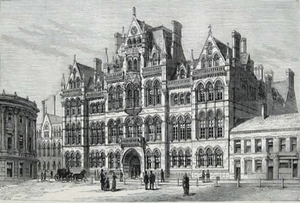Francis William Aston facts for kids
Quick facts for kids
Francis William Aston
|
|
|---|---|

Aston in 1922
|
|
| Born | 1 September 1877 Harborne, Birmingham, England
|
| Died | 20 November 1945 (aged 68) Cambridge, England
|
| Nationality | English |
| Citizenship | British |
| Alma mater | Mason College (as issued by University of London) Trinity College, Cambridge |
| Known for | Mass spectrograph Whole Number Rule Aston Dark Space |
| Awards | Mackenzie Davidson Medal (1920) Nobel Prize for Chemistry (1922) Hughes Medal (1922) John Scott Medal (1923) Paterno Medal (1923) Royal Medal (1938) Duddell Medal and Prize (1944) |
| Scientific career | |
| Fields | Chemistry, physics |
| Institutions | Trinity College, Cambridge |
| Doctoral advisor | Percy F. Frankland |
| Other academic advisors | J. J. Thomson John Henry Poynting William A. Tilden |
Francis William Aston (born September 1, 1877 – died November 20, 1945) was a British chemist and physicist. He won the Nobel Prize in Chemistry in 1922. He earned this prize for discovering isotopes in many elements that are not radioactive. He also created the "whole number rule" using his special invention, the mass spectrograph. Aston was a member of the Royal Society and Trinity College, Cambridge.
Contents
About Francis Aston
Early Life and Education
Francis Aston was born in Harborne, England, on September 1, 1877. He was the third child in his family. He went to school at Harborne Vicarage School and later at Malvern College.
In 1893, Francis Aston started studying at Mason College. This college was part of the University of London at the time. There, he learned about physics and chemistry. He even did extra research on organic chemistry in a lab at his father's house. Later, he worked at a brewery for a few years. In 1903, he went back to the University of Birmingham to continue his studies.
Amazing Discoveries
After X-rays and radioactivity were discovered, Aston became very interested in physics. He studied how electricity moved through tubes filled with gas. This research helped him understand something called the "Aston dark space."
In 1910, a famous scientist named J. J. Thomson invited Aston to work at the Cavendish Laboratory in Cambridge. Thomson had discovered the electron. He was now studying positively charged particles called "Kanalstrahlen" (also known as anode rays). Scientists found that they could use magnets and electric fields to separate these particles based on their weight and charge. This showed that atoms of the same element could have different weights. This idea led to the invention of the first mass spectrometer.
Aston's main goal was to find out if different versions of the same element, called isotopes, really existed. He worked on finding isotopes in elements like neon, chlorine, and mercury. His research was paused during First World War, when he worked on coatings for airplanes.
After the war, Aston went back to his research. In 1919, he finished building his first mass spectrograph. This amazing machine helped him identify 212 different naturally occurring isotopes!
In 1921, Aston became a member of an international committee that deals with atomic weights. The next year, he won the Nobel Prize in Chemistry for his important work.
Aston's studies on isotopes also led him to create the "whole number rule." This rule says that if you set the weight of the oxygen isotope to 16, then all other isotopes have weights that are very close to whole numbers. This rule was very important for developing nuclear energy. He even thought about how we could use the energy inside atoms.
Aston wrote two well-known books: Isotopes and Mass-spectra and Isotopes.
Hobbies and Later Life
Francis Aston was a very active person. He loved sports like cross-country skiing and ice skating when he visited Switzerland and Norway. When he couldn't do winter sports during the war, he started climbing mountains. He also enjoyed cycling, and even built his own car engine in 1902! He took part in a car race in Ireland in 1903.
Besides these, he liked swimming, golf (often with his friend Ernest Rutherford), and tennis. He even learned surfing in Honolulu in 1909. Aston was also a talented musician, playing the piano, violin, and cello. He traveled a lot, visiting places like Australia and New Zealand.
Aston was also a skilled photographer and loved astronomy. He joined several trips to study solar eclipses in different parts of the world, including Sumatra and Japan.
Francis Aston never married. He passed away in Cambridge on November 20, 1945, when he was 68 years old.
Legacy
- The lunar crater Aston on the Moon is named after him.
- The British Mass Spectrometry Society gives out the Aston Medal in his honor.
See also
 In Spanish: Francis Aston para niños
In Spanish: Francis Aston para niños



